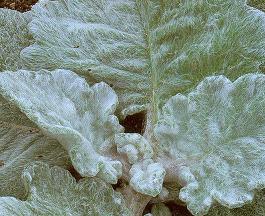SALVIA argentea (Silver Sage) Silver sage is just one of over 900 species of salvias. Unlike most in the group that are grown for their flowers, silver sage is generally prized for its eye-catching, furry silver leaves. Children and adults alike have a hard time resisting petting the soft, appealing foliage. This award-winning plant has been given the Royal Horticulture Society’s prestigious Award of Garden Merit.
Use silver sage as a specimen plant, an accent plant in the rock garden, or at the front of the dry sunny border. A grouping of these plants makes a stunning ground cover. Silver sage combines well with other drought tolerant plants, such as lavender, yarrow (Achillea) or Russian sage (Perovskia).
It is a nice complement for purple or magenta flowers, and it looks gorgeous in a “white” garden. Silver sage grows best in rich, well-drained soil in full sun to partial shade. Hairy-leaved plants and high humidity often do not go together. In the Midwest, good results require full sun and sharp drainage (naturally sandy soil or soil amended with gravel). These plants must have excellent drainage, especially in winter, in order to thrive. Protection from winter wet will help survival. Silver sage can also be grown in containers. Space new plants in the ground two to three feet apart.
In the winter the plant dies back mostly to the ground, but it is best to leave the old leaves on the plant (even though this does not look very good) until new growth resumes the following spring. The large leaves seem to help shield the crown from excess moisture, keeping the soil around the base drier and helping winter survival.
Silver sage flowers in early to mid-summer after its first year. Although the two-to-three-foot candelabra-like flower spikes can be dramatic, the conspicuous white or green bracts and small white or yellowish flowers are not particularly impressive. Developing flowers causes the foliage to deteriorate and weakens the plant. It is best to remove the flower spikes while they are still small and before they set seed (unless you wish to propagate the plants) to help the plant itself live longer.
A Northern Sunset biennial, it prefers average, well-drained soil in full sun.
(Image courtesy of Ivy Garth Seeds)

